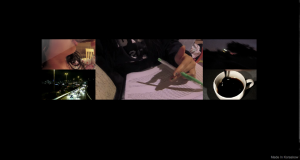Constraint Task: Someone Else
Sketches
This week Seth reminded the class that our weekly constraint tasks are simply sketches, which got me thinking about what exactly a sketch is. Seth used the words – rough, unfinished, draft.
Seth mentioned a resource by Bill Buxton called ‘Sketching user experience.’ Buxton defines a sketches as
– timely
– inexpensive
– disposable
– having minimal detail
– having an appropriate degree of refinement
– are ambiguous.
Student K-Film Exploration: Life is a Musical
I have really enjoyed watching past students K-Films. It has really helped me understand the possibilities of Korsakow and got me thinking about by own K-film sketch.
Life is a Musical
Red Hat: I engaged with the variety of different clips throughout the project and liked the use of rhythm to drive the piece.
Black Hat: The difference in quality of the clips. There was also some distorted sound in the clips that were filmed outside which became distracting at times.
Yellow Hat: I really liked the idea as it brought to life everyday sounds that would usually go unnoticed
Green Hat: Mixing up the types of sounds to avoid too much repetition
Constraint Task: Self
Constraint Task: Place
Constraint Task: Family
David Bordwell’s Website on Cinema
For all things David Bordwell
Week 4: Lecture
Bordwell and Thompson state that after watching Rail Road Turnbridge a person “cannot see bridges in the same way” thus experimental films are not just art for arts sake. Can/are Korsakow projects art for arts sake, or can they effect the way people see things? Or like Rail Road Turnbridge are they both at once?
- Korsakow films can absolutely change the way both viewers and creators see things
- Jasmine told an excellent anecdote when she was a child she would pretend to be a time traveller and would imagine seeing the world through new eyes. This gave her a greater appreciation of the world around her – taking the familiar and making it unfamiliar
- Less about what things mean and more about their materiality
- non-narrative documentaries and Korsakow films have the same effect on viewers and utilise different ways to set up patterns
Bordwell and Thompson devote a lot of attention to the formal structure and sequence order to deconstruct films, yet through some i-Docs the individual creates their own unique structure. What other methods can we employ to deconstruct i-Docs, and does this interactive structure take some creative control away from the author/filmmaker?
- Korsakow structure created by the producer – taxonomy of keywords
- You don’t need to necessarily define something to be able to construct it
- Creator = Architect and User = Builder
- Closed reading is not deconstruction
- Katherine Hail: writing should be specific depending on medium
- User decides when the segment is over – takes away some of the creative control
- Designers for providing users with experiences
Do the readings of experimental films rely on the audience that is observing them? And if so to what extent is experimental film an interpretation?
- Relies on interpretation
- All films rely on audience to interpret them – experimental is not specific
- Realist narrative – hides the fact that its pretend
- Linear/fixed – you are in control
Week 4 Reading: Film Art – An Introduction
This week’s reading from Film Art: An Introduction by David Bordwell and Kristin Thompson introduces different styles of film making.
Narrative
Narrative can be described as a chain of events in cause-effect relationship occurring in time and space. Typically there is one situation presented at the beginning of a narrative, a series of changes occurs according to a pattern of cause and effect; finally a new situation arises that brings about the end of the narrative. An introduction, a complication and a resolution.
“I had actually trapped myself in a story that was very convoluted, and I would have been able to cut more later if I’d simplified it at the script stage, but I’d reached a point where I was up against a wall of story logic. If I had cut too much at that stage, the audience would have felt lost.” – James Cameron, director, on Aliens
Plot and Story
- The viewer makes sense of a narrative by identifying its events and linking them by cause and effect, time and space. Viewers also infer events that are not explicitly presented. Adrian used the example in the lecture of time passing in film. Day to night.
- Distinction between story and plot (sometimes called story and discourse)
Cause and Effect
- Characters are usually the agents of cause and effect – they make things happen and respond to events. Their actions and reactions contribute strongly to our engagement with the film
Time
- The viewer constructs the story time on the basis of what the plot presents.
Space
- In film narrative space is usually an important factor – events occur in well defined locales.
- Cinema employs screen space – the visible space within the frame
Experimental Film
Experimental film is intentionally unconventional in the way it avoids the content mainstream cinema produce and the style in which they create it.
Experimental films are made for many reasons
- Filmmaker may wish to press personal experiences or viewpoints in ways that seem eccentric in a mainstream context
- Filmmaker may want to portray a mood or a physical quality
- Filmmaker may wish to explore possibilities of the medium itself
Types of Experimental Film
- Abstract film – often organised in around theme and variations (usually refers to music)
- Associational Form – groups images that may not have immediate logical connection but the very fact that the images and sounds are juxtaposed prods us to look for some connection – an association binds them together.
